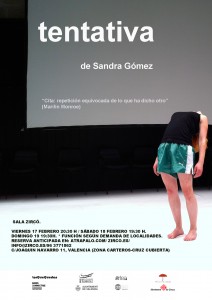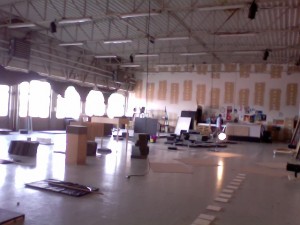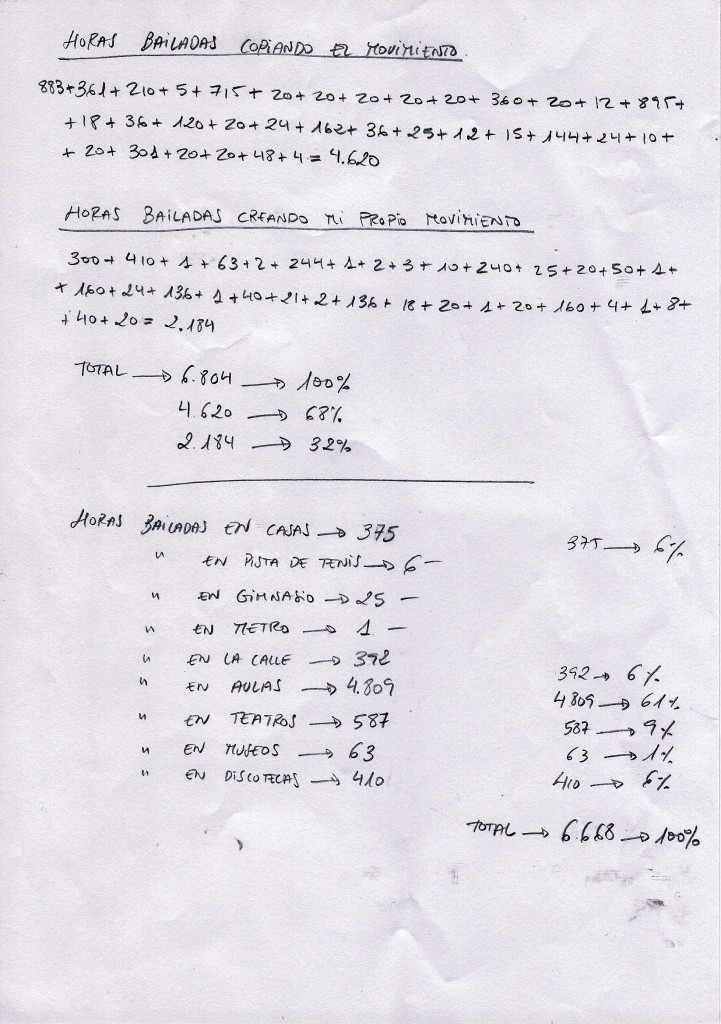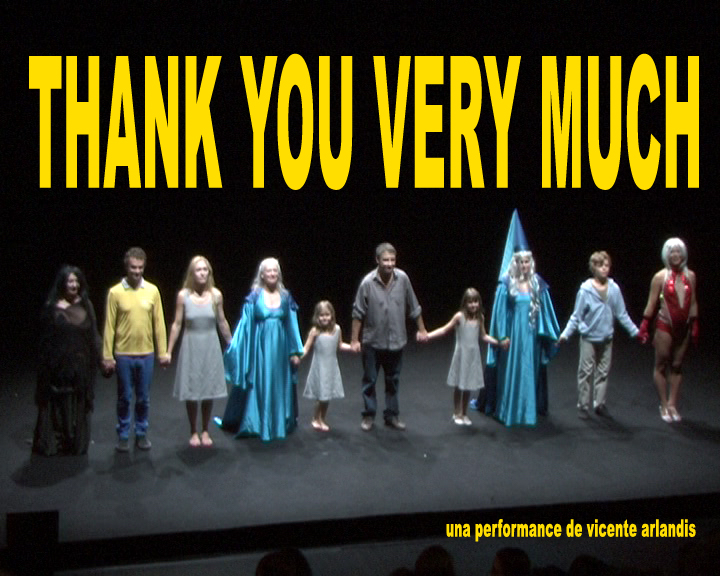Blogroll
-
Entradas recientes
Meta
Hola gente, aquí os dejo el vídeo del último trabajo de la sandra, TENTANTIVA.
Publicado en General
3 comentarios
TENTATIVA de Sandra Gomez. Sala Zircó. Valencia
Hola a tod@s.
Os queremos invitar a que vengáis a disfrutar de nuestro último trabajo. Se llama Tentativa y es una propuesta a la que Sandra ha estado dándole vueltas los últimos meses.
Lo estrena en Valencia, en la Sala Zircó este próximo fin de semana. Viernes 20:30 y Sábado 19:30.
Sabemos que con la cantidad de inauguraciones, exposiciones, bienales, trienales, sentadas, manifestaciones, filmotecas, festivales, certámenes, caceroladas. conferencias, conciertos, instalaciones, vernissages, encuentros, performances, actos poéticos, desayunos, site especifics, new environments, happenings, y otras manifestaciones culturales fuera de los ordenes de clasificación propios de nuestra época contemporánea que se dan cita en nuestra querida ciudad, no será fácil elegir … pero nos gustaría compartir con todos vosotros este trabajo.
Y sin más, un beso para todos
Y viva la danza.
Publicado en General
Comentarios desactivados en TENTATIVA de Sandra Gomez. Sala Zircó. Valencia
Settlement, espacio compartido propuesto por Vladimir Miller (a.pass)
Vladimir Miller is researching and developing a spatial strategy for shared production of work, which he calls «settlement». This strategy asks the participants to occupy one space together for a given time and build structures, modules, stations, spots, etc, suitable to their work and collective requirements in that shared space.
By finding a spatial manifestation and localisation for their work the settlers enter a growing and evolving network of objects, spaces, ideas, events and encounters in the shared space. As the emphasis of the work-process and the activity of the individual and of the group change from day to day, the settlement stays a dynamic structure, ready to be reformed according to the present requirements for production and presentation.
The settlement as a proposal is asking its participants to come and practice their work in a shared environment. The method is to build everything from scratch on location that is required to work and communicate a practice to other participants. This can be anything from an improvised table to hold a laptop to an elaborate, secluded structure; from temporal impromptu arrangements to specific spaces that last for the whole work period. Settlement allows for a re-negotiation of the specific conditions of each practice. As it manifests itself in the workspace, a loop of condition and production is created in that shared space: in the course of the three weeks the settlement lets a particular method of production and sharing find its own intrinsic spatial conditions, free from the sets of rules and behaviours usually provided by ready-made spaces such as “table”, “studio”, “meeting”, “gallery”, “venue”, “library”, etc.
Along with the set of metaphors that the word «settlement» suggests, structures emerge in the space, habit settles in, artistic territory is established, shared and challenged through the non-verbal negotiation of building and sensing the margins of «mine» and «ours». The political questions inherent in claiming one’s own space, inviting or excluding the outside, the formation of groups and production of locality and culture, constantly question the structures inherent in the concept of settlement itself. Between anarchy and the rule of majority the settlement practice actively searches for a spatialised production of a contributive dis-agreement by giving space to a literal heterotopia of work processes.
* object-oriented practice
With its attention to space and spatial manifestation the settlement is also a proposal towards an object oriented collaborative practice. The word «object» here means any kind of material or immaterial assemblage of things, thoughts and actions. “Object-oriented” is emphasized to point out a difference to the methods of collaborative work where the artist (as the respective «subject») is the main source of knowledge, representative and entry point into a specific artistic know-how. It is furthermore not to be understood as “product-oriented”, as it understands the manifested praxis itself as an object.
I would like to actively shift the sentence/gesture of «this is my practice» towards «this is the practice I am using» as far as possible, in order to challenge the territorial tendencies in production of art and knowledge and to provide an actual entry point for the other participants to learn, influence and evolve a given practice contributively. The dichotomy of «what I do» – «the other» (the artist/work and its audience) can shift towards a triangle of «I»–»what is done»– «the other», providing the “outsider” with an independent connection to a praxis and the means to evolve it. In the settlement the practice of building and thus situating oneself in the collective space evolves through the question of «how can what I assemble become the entry point to the practice-knowledge that I use in such a way that anybody can invest in learning it, resuming the work where I have left it off and evolving it further?» What then develops can be compared to a wiki, where the practice evolves not unlike an article of a wiki-encyclopedia, yet with the difference that new developments do not erase other/previous version of the practice, but add to it as to an ever growing file or folder. This “file/folder” becomes thus, as the settlement is itself, an autonomous space of contributive dis-agreement.
An object oriented practice proposes to work as much on the artistic practice itself as on the means of how to communicate and make it available besides/beyond the known strategies of the artist assuming a teachers position towards his work or creating products to represent it.
* openness and invitation
The settlement is a structure that is open to visitors. The invitations to the visitors that may come to the settlement during the course of the works is made on the same grounds as the invitations made to the initial group of artists. The settlement does not invite audience as an event, all invitations are personal and the emphasis of their purpose is on collaboration and mutual influence rather then on presentation and display. There is no centralised mechanism of invitation, the responsibilities of hospitality are individual and not institutional. Being a visitor in the settlement can be a gradual process of «sticking around». Settlers are welcome to invite visitors, and the visitors are welcome to become settlers themselves. In fact the very act of individual invitation makes any kind of role-naming obsolete in this case. The particularities of how to deal with an «outside» are part of the individual practice and depend on group- and individual decisions during the settlement.
Openness as a structural model strives to provide the outsider with the means and the tools to influence, evolve, modify and even to destroy it. (see also education*). Following a politics of hospitality, an openness does not delineate roles or modes of participation – does not distinguish between the artist and the viewer, the producer and the visitor, etc., but allows for a gradation/continuum of involvement and influence for any participant. This openness cannot be achieved by merely inviting spectators into the space, because inviting someone “as a spectator” produces a limiting trajectory for his or hers possible involvement in the present practice. This initial hierarchy of contribution is what participatory concepts try to subsequently eliminate, after establishing it in the first place.
An individual invitation establishes a non-hierarchical mode of hospitality to every new visitor. Any visitor can become a tourist, a frequent visitor, a collaborator, a critic, a settler himself, even if his/hers choice of involvement is that of a spectator. The practices resulting out an invitation (hospitality, responsibility, information, etc) and the limitations (how many visitors can the settlement “handle” if it really takes the work of inclusion upon itself?) confront the individual praxis with the possibility to re-negotiate its relationship to communication outside of institutional requirements.
The attempt to invite everybody as a possible settler is taking every encounter as an opportunity to evolve the settlement. The praxis of invitation is at the same time open and limited to the actual possibilities of an individual dialogue.
*education
– The sum of actions required to provide the initial outsider with the structural knowledge and the tools to step into, influence and evolve an existing or developing structure.
– The sum of actions required to release and pass on artistic ownership.
– The sum of actions to bridge a gap in knowledge and know how.
– The work of translation.
Every structure, be it the settlem
Publicado en Games
Etiquetado a.pass, apt, formacion, settlement, sharing space, taller
3 comentarios
El rito como un juego sobre la realidad.
una peli muy chula de jean rouch.
Les maîtres fous – Jean Rouch (1951) VO sub.esp. from reinadafrica on Vimeo.
Publicado en Games
Comentarios desactivados en El rito como un juego sobre la realidad.
TENTATIVA DE INVENTARIO de Sandra Gómez (En proceso)
Hola a todos los compis del tea-tron. Últimamente estamos un poco dispersos ya que nos mudamos de Valencia para Bruselas por un año.
La cosa es que estoy trabajando sobre el JUEGO y la INUTILIDAD y me he apuntado al carro de hacer un plan de investigación/doctorado llamado APASS muy interesante entre Amberes y Bruselas. Pero antes de eso, durante 10 días, la Sandra ha estado trabajando en su proyecto TENTATIVA DE INVENTARIO en el Centro Cultural La Mercè de Girona gracias a la Convocatoria de Creació escènica CCM-Cèl.lula.
Os invitamos a los que estés por aquí el jueves 26 mayo a las 21h. a ver el trabajo en proceso TENTATIVA DE INVENTARIO y a la charla que tendremos luego sobre el mismo.
TENTATIVA DE INVENTARIO
¿Qué revela la experiencia personal entorno a la danza?¿Es posible que la “historia personal” introduzca nuevos elementos en el relato de la “historia oficial”? ¿Cómo ordenar y clasificar los hechos y datos subjetivos?.
Tentativa de inventario es un trabajo autobiográfico donde el uso de la memoria es un instrumento de construcción y donde el cuerpo y su presencia son tratados como un archivo orgánico.
Este trabajo fue iniciado dentro del proyecto de investigación Autonomía y complejidad de ARTEA en colaboración con AZALA Espacio de Creación.
Proyecto seleccionado para la residencia de creación escénica Cèl·lula-CCM.
www.festivalmapa.com / www.girona.cat/ccm
Con losquequedan colabora Centro Coreográfico de la Comunidad Valenciana/Teatres de la Generlitat Valenciana y Ayto. de Valencia.
www.losquequedan.com
Publicado en General
1 comentario
THANK YOU VERY MUCH en la Sala Carme. Valencia.
Publicado en General
Comentarios desactivados en THANK YOU VERY MUCH en la Sala Carme. Valencia.
esto es arte porque yo lo digo#2
Aquí os dejo una noticia extraida de EL PAÍS acompañada de un magnífico vídeo.
(http://www.elpais.com/articulo/cultura/pista/patos/goma/naufragos/elpepucul/20110301elpepucul_8/Tes)
Vídeo:
Tras la pista de los patos (de goma) náufragos
Un periodista estadounidense reconstruye en un libro la aventura de 29.000 juguetes que se cayeron de un carguero en el océano y flotaron durante años.- Su destino sirvió a los oceanógrafos para estudiar las corrientes marinas
Probablemente al principio tuvieran miedo. Una cosa es una bañera. Otra, el océano. Pero finalmente debieron de cogerle gusto, dado que algunos siguen dando vueltas por el globo 19 años después. Ahora, los 28.800 patos amarillos (la mayoría), castores rojos, ranas verdes y tortugas azules de plástico que en 1992 cayeron de un barco que navegaba por el Pacífico, hasta podrían volver a encontrar a sus antiguos amigos. Ni que fuera Perdidos. El periodista estadounidense Donovan Hohn ha reconstruido, en su primer libro Moby Duck (que se puede adquirir en Amazon) trayectos y destinos de la mayoría de los juguetes y de otros objetos que flotaron por el mar, en una mezcla de ternura, picos sonrientes, corrientes oceánicas y polución. «Tenía que ser un trabajo corto. Me ha costado sin embargo cinco años y viajes por todo el planeta», cuenta el autor por teléfono desde Nueva York.
El 10 de enero de 1992 una tormenta sorprendió cerca de las Islas Aleutianas a un carguero que cruzaba el océano Pacífico de Hong Kong a Washington. 12 contenedores cayeron por la borda, uno se abrió y llenó el mar de miles de juguetes producidos por la compañía china First Years Inc. Los animalitos se dispersaron, presas de las corrientes oceánicas. Un naufragio conmovedor que una compañía de coches aprovechó años después para un vídeo publicitario. Pero desde el principio el asunto cogió también otro camino, más serio.
Varios oceanógrafos se dieron cuenta de que los patos que tocaban tierra solían desembarcar en determinadas zonas. Hasta llegaron a realizar un mapa que se basaba en las corrientes y reconstruía los trayectos de navegación de los patitos. El oceanógrafo y cazador de juguetes náufragos Curtis Ebbesmeyer encontró el punto exacto en el que el container se había caído. Y, según contó a The Independent, aprovechó los movimientos de los juguetes para estudiar el giro oceánico (una gran corriente constante y circular) del Pacífico Norte, entre Japón, Alaska e Islas Aleutianas, descubriendo por primera vez que un objeto tarda tres años en completar el ciclo.
En 2005 Hohn, fascinado por esta aventura, empezó a tirar del hilo. Su investigación le llevó a contactar con Ebbesmeyer, del que recibió una sorprendente respuesta: «No puede cazar a los patos por teléfono. Tiene que salir de casa y buscar», como publicó The New York Times. Hohn le tomó la palabra. «Primero fui a China, a la fábrica donde construyeron los patos», explica. Y luego empezó a recorrer los sitios del mapa. Escocia, Hawai, incluso cogió un crucero para viajar por el mar Ártico. Una larga ruta con un imprevisto agradecido: «En una playa escondida y desierta, en Alaska, encontré a un castor de plástico, escondido bajo un árbol. No contaba con que a lo largo de mi ruta hallaría a uno de los animalitos».
El castor, que en un tiempo fue rojo y ahora es más bien blanco, está en su casa. Pero, ¿cómo puede estar seguro de que sea uno de los miembros de la flota de juguetes? «Por la marca, el color, el material. Hay pruebas ciertas. En cambio después de los primeros hallazgos se desató un entusiasmo por el que todo el mundo decía que había encontrado uno de los animalitos famosos».
La mayoría de los patos han acabado en las playas del mapa, tras un viaje largo y peligroso. Según Hohn, «la imagen más encantadora de todo esto es la de un minúsculo pato amarillo que desafía en solitario al océano salvaje». Muchos le han ganado el pulso a la naturaleza, a costa de perder su color original y están a salvo, en casas de coleccionistas o cazadores casuales. Centenares de juguetes sin embargo se han deteriorado y han acabado hechos pedazos. Pero «debe de haber cientos que todavía están flotando», sostiene Hohn. Y cuenta: «Varias veces me he imaginado estar tumbado en la playa y de repente ver aparecer en el horizonte un patito amarillo». Ese patito sería hoy 19 años más viejo y tendría el pico sonriente de quien ha sobrevivido al océano.
Publicado en esto es arte porque yo lo digo
Comentarios desactivados en esto es arte porque yo lo digo#2
cosas que solo un artista puede hacer#10
Una de las cosas de las que últimamente hablan muchos amigos es ésta : DESAPARECER.
Bas Jan Ader, otro de mis «favourite artists» desapareció al intentar cruzar el Atlántico en un pequeño barco de vela.
David Horvitz le rinde homenaje con este vídeo tan suave y sutil.
Publicado en Cosas que solo un artista puede hacer
3 comentarios
Esto es arte porque yo lo digo#1
En mi pueblo, Ibi (Alicante) , el juguete ha sido desde principios del s.XX el sustento de toda la población. Mi padre trabajaba en una fábrica de juguetes, mi madre también, y mi hermana sigue trabajando en una de ellas. Y de alguna manera yo también siento que lo que hago, y sobre todo lo que me gustaría hacer son juguetes.Aquí va un vídeo que, sobre todo la primera parte es la chula. El día de reyes, como no podría ser de otra manera es un día muy especial. Existe una asociación a la que puedes entregar los juguetes de tus hijos para que el día 5 por la noche entren los negros, armados de escaleras, a tu casa con las cajas de juguetes. Yo recuerdo haber flipado con los negros abriendo la ventana del comedor de mi casa con un montón de cajas. Y todavía sigo flipando viendo a los negros subir y bajar por las escaleras. Ahí va: http://www.facebook.com/video/video.php?v=1475014844293
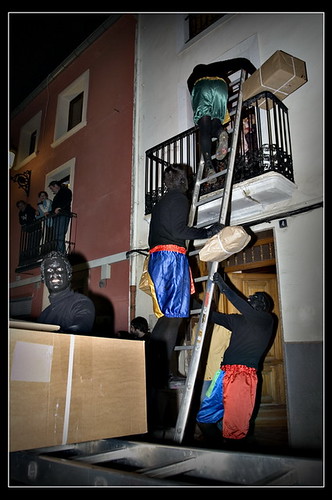
Publicado en esto es arte porque yo lo digo
1 comentario
Cosas que solo un artista puede hacer #10
Peter Fischli & David Weiss
Oso: -¿Qué significa ese disparate?
Rata: pero, ¿es que no entiendes? El mundo es de los ambiciosos. Iremos al mundo del arte, parece que ahí se está cociendo algo… – Acción – cultura – dinero!
Oso: ¿Hay trabajo?
Rata: No, dinero
Oso: Pero, ¿Cómo?
Rata: ¿Con…engaño? …en el mundo del arte…, nos forraremos y haremos como los demás. Sólo que mucho mejor. Es verdad que no entendemos ni gota de eso, pero todo se andará…, haremos un viajecito de estudios”
1983 „Der rechte Weg“ (The right way), 16 mm, 52 minutes, color, sound, Journey of the artist through Switzerland, as a rat and a bear
Publicado en Cosas que solo un artista puede hacer
Comentarios desactivados en Cosas que solo un artista puede hacer #10
